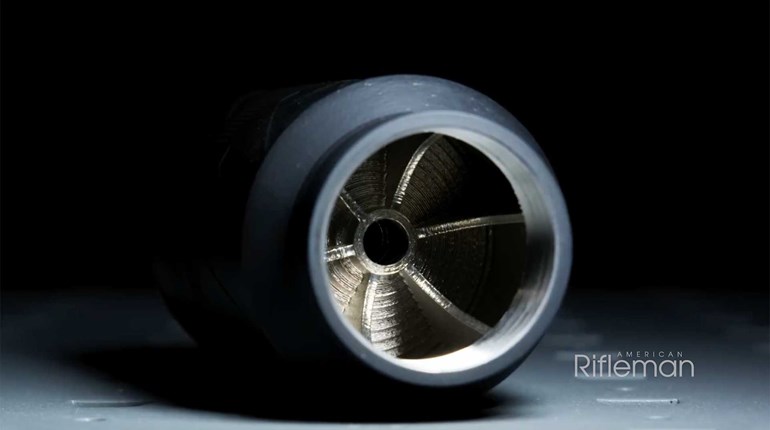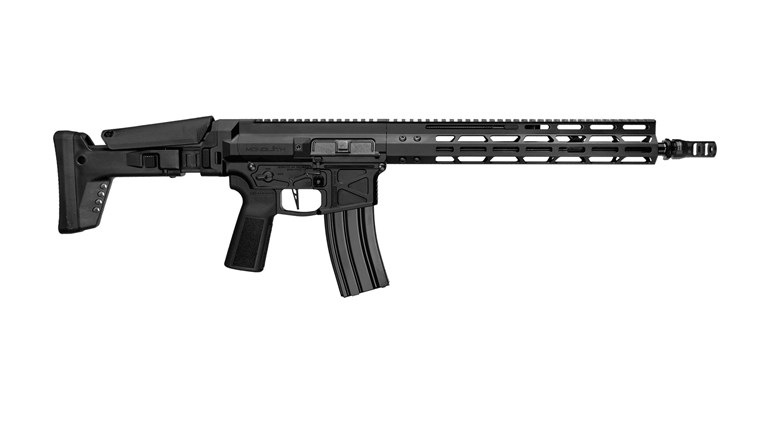
More than a half-century ago, when small-arms genius Eugene Stoner designed his M8 prototype AR-10 rifle, he went out of the box. Stoner took a piece of Melvin Johnson's bolt and the Swedish Ljungman's direct-gas tube to create a whole new ball game in rifle-operating systems. Transferring the gas through an elongated gas tube (an extended gas port), Stoner directed the gas into a bolt carrier where some fascinating things happened.

With an enlarged section of the interior of the carrier housing a precisely fitting rotating bolt, the carrier became a gas cylinder, and the bolt a piston. When the rifle was fired and the bullet passed the gas port, gas was transferred through the gas tube into the carrier, unlike the Ljungman where the gas impinged directly onto the carrier. When the gas entered the M8's carrier, it "inflated" the internal chamber, exerting equal pressure against the carrier and the bolt.
As the expanding gas began to force the carrier to the rear, it also forced the bolt forward, and for a milisecond this off loaded the lugs of the bolt just as it rotated to unlock. By the time the bolt did unlock, the bullet left the barrel. The bolt and carrier continued rearward, extracting and ejecting the empty case and the cycle was repeated. Thus, a fitting technical operating description of Eugene Stoner's AR operating system is "long-stroke piston and cylinder by direct-gas transfer," this last word being an excellent addition by George Reynolds of Knoxx Industries to better describe the operation. After ironing out some unintended and unforeseen problems early on, the AR-10's sibling, the AR-15/M16 proved, by most accounts, to be a highly reliable rifle.
However, when the barrel and gas tube of the M16 were shortened, the gas port was, by necessity, moved roughly 4 inches to the rear and much closer to the point of peak pressure. This brought much more heat into the bolt group along with unburned propellant residue and wear and tear. To illustrate this, the speed of the bolt group in a standard M16 rifle is 160 inches per second (ips), whereas that of an M4 Carbine is 240 ips. In shorter barrels there is also the issue of dwell time, or the time the bullet is in the barrel after it passes the gas port until it exits, leaving enough gas pressure to cycle the action.
Conventional Pistons
A solution to most of the above problems has been to convert Stoner's AR platform to conventional piston operation, something he sought to avoid in his original design. Virtually all such designs have been of short-stroke design, where a piston roughly 2 inches in length in the gas block impinges on an operating rod with its own return spring in place of the gas tube. The rod in turn impinges on a solid replacement of the bolt carrier's hollow gas key and drives the bolt group to the rear, much like a pool cue drives a cue ball.
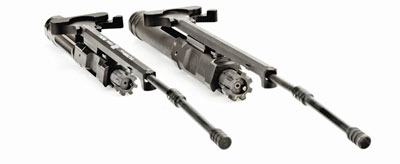
Short-stroke piston systems normally add about seven parts to an AR, and these parts do nothing more than drive the bolt group rearward, the remainder of the time lying stationary above the barrel. In addition to performing the above function, a long-stroke piston is connected to the bolt carrier and runs with it the entire length of travel to the rear and back into battery. The weight of the long-stroke piston, therefore, becomes part of the bolt group's mass, increasing its kinetic energy and improving the rifle's reliability.
Other than the excellent South Korean K2 rifle that was designed from the start to use a long-stroke (AK-type) piston, this operating system has been applied to no other AR-pattern rifles—until now. The company that designed and manufactures this superb system is Primary Weapons Systems (PWS) , of Boise, ID, but its long-stroke piston system is not offered in just one basic weapon, but two, and within both models are multiple variations. (For a complete photo gallery of the PWS MK116 and PWS MK216, go here.)
In general, the two platforms are an AR-15 style and one based on Stoner's AR-10, but a lot changes from there. First, while PWS manufactures the main components in-house to the strictest specifications, this company is not afraid to use others' components. These include parts that have been accepted as some of the best in the business, such as Bravo Company and Magpul. The two basic models are the MK1, and MK2, both designated as multi-caliber and both offered in several configurations. My test samples came with 16-inch barrels.
PWS MK116 5.56 NATO
Essentially an AR-15-type platform, the MK1 is available in calibers friendly to the standard AR-15-size magazine well, and the upper- and lower-receiver components are in standard A4 configuration made from mil-std 7075-T6 aircraft-quality aluminum forgings. With a match-grade, medium-contour, 16-inch barrel, the muzzle is threaded 1⁄2x48 for the now-famous PWS muzzle brake/flash hider adopted by FNH USA for the SCAR.
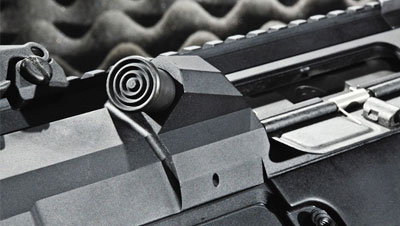
Arriving at the gas block, we find PWS' unique mil-spec quad-rail system leading to a bulkhead attached to the special barrel nut. The top rail is enlarged and hollow, with vents on either side and a port on the bottom roughly 2.75 inches to the rear of the gas port. Inside this rail is the gas cylinder that extends from the gas block. Inside it is the rifle's long-stroke gas piston—the crowning functional element of PWS rifles.
At the 3-, 6- and 9-o'clock rails at the rear bulkhead are mounts for QD sling swivels. Located at the rear of the receiver's flat-top rail and the front end of the extended top rail are a pair of Magpul's flip-up MBUS sights. An enlarged Magpul trigger guard is also standard, as well a Magpul MOE pistol grip. The PWS logo and name are engraved into the left side of the magazine well along with the serial number. All other aspects of the receiver group are standard, and its magazine well will accommodate other calibers friendly to it.
The charging handle furnished is Bravo Company's Mod 4 Gunfighter model with an extended latch and to the rear is PWS' innovative M4-type recoil-spring tube. Fluted for extra strength, this tube also has an integral reinforced ring at the front, on which the stock bottoms out when collapsed. On either side of this ring are QD single-point sling mounts, but the tube holds a never-before-seen secret. This is an extension, or "lip" at its lower front where it screws into the lower receiver on which the rear end of the bolt carrier rests when in battery.
Equally impressive, the PWS bolt carrier is enlarged at its rear to prevent it from tilting downward when it begins to move after the rifle is fired—a common problem with conventional piston-driven ARs. The tube extension pre-positions the carrier to make a perfectly smooth transition through the tube when cycling. The stock is the Magpul MOE, and the rifle also comes with Magpul's equally fine 30-round Pmag.
PWS MK216 7.62 NATO
Although larger than its 5.56 NATO sibling, the MK216 is identical to it, but for several important aspects. First, the PWS muzzle brake/flash hider is almost twice as long and the muzzle of its 16-inch barrel uses 5⁄8x24 threads. The MK216's receiver group is also quite different.
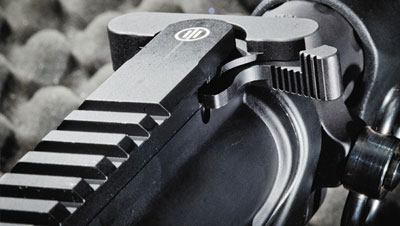
Somewhat resembling an SR-25, the MK216's upper receiver has octagonal sides and a forward assist positioned close to the ejection port that also serves as a case deflector. The lower receiver has a forward-angled front with chevron grooves for use by shooters who like to hold the rifle there. A Magpul MOE-style trigger guard is part of the receiver.
All else appears to be exactly the same, except for the absence of the bolt-positioning spring used in the MK116, and the MK216's longer recoil-spring tube. This part is of the same inside diameter as that of the MK216 and the rear of the AR-10-size bolt carrier is the same 1-inch diameter as on the MKI. The MKII comes with Magpul's superb 20-round SR-25 sized Pmag LR. As the PWS MK1 Series is with .223 Rem.-sized rounds, the MK2 Series will be offered in other calibers friendly to the 7.62 NATO (.308 Win.) size magazine well.
At the Range
Shooting the PWS MK116 and MK216 rifles brought no big surprises. Operation was as smooth as silk, but for the standard-issue trigger pull. Both carbines will accept any aftermarket AR trigger. Accuracy wise, the two guns produced 100-yard groups in the 1.5- to 2.5-inch range when equipped with optics. The Trijicon 4x32 mm ACOG was used on the PWS MK1 and a Leupold MR/T 1.5-5x20 mm scope topped the MK216 .308 Win.
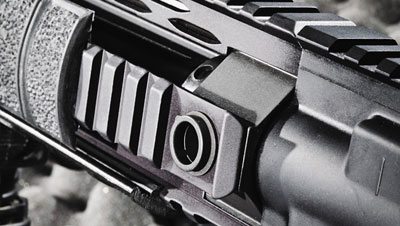
The Leupold scope was mounted in the new, fully adjustable #72 EXT Throw Lever Mount from A.R.M.S. This mount also has an internal device that dampens harmonics to increase the life of optics by as much as 75 percent.
Installation of some optics requires removing the rear MBUS from the rifle due to clearance or eye-relief problems. As this reaches you, Magpul's new low-profile MBUS will be available, so it might eliminate such problems. If not, the Aimpoint CompM4 or EOTech XPS might provide a simple solution. Both carbines were tested from the bench using sandbags, as well as Carrol's Ultimate Precision Shooting Rest. There were no malfunctions or stoppages with either rifle.
Other Accessories
For a sling, I mounted a Blue Force Gear Vickers Sling on the MK216 and a Wilderness Tactical Giles Sling on the MK116 using standard push-button QD sling swivels. I also tried a Grip Pod with a rail equipped with a powerful SureFire G2 LED Tactical Light, held in a Vltor Ring Mount on both carbines. Positioned just far enough back on the bottom rail to allow the mounting of a LaserMax Uni-Max micro laser, this proved to be an ideal setup with the thumb-activated light on the right side and the finger activated laser directly under the barrel. The whole system weighed in at just 14.75 ounces
The Future of AR Pistons
There's no doubt that conventional piston systems and conversions for the AR platform are here to stay. Thus far, all have been of short-stroke operation and most work very well. Some are complex—with parts easily becoming lost—and some are adjustable for the amount of gas used. The PWS long-stroke piston, like that of the AK, needs none of this complexity to work all the time, and there are no piston parts to lose. It was designed simply to work without fail.











